True Secrets of the Combine Seating Chart

INDIANAPOLIS — Last Wednesday morning at 5 a.m., two sets of scouting interns were in the bowels of Lucas Oil Stadium, jockeying for position. Weigh-ins for the first group of prospects at the combine would take place later that morning, and the Browns and Chiefs were seeking to lay claim to the seats closest to the stage where over the next four days some 300 players would walk across shirtless and get their measurements taken.
“It was a battle between us and John to get our front row,” said Chiefs GM Brett Veach.
The front-row weigh-in tradition was started in Kansas City by former GM John Dorsey, who was fired by the Chiefs last year and hired in December by the Browns. So it’s no surprise those were the two staffs battling it out. It’s a rite of passage for the interns to wake up before dawn and head to the stadium to secure the coveted spots. “John had a couple tricks up his sleeve,” Veach said in good humor, but both teams ended up with seats in the front row.
“It’s kind of a representation of your staff,” Veach said. “We’re going to be here, we’re going to start early, we’re going to finish late. It’s more pride for what you do, a tone-setter.”
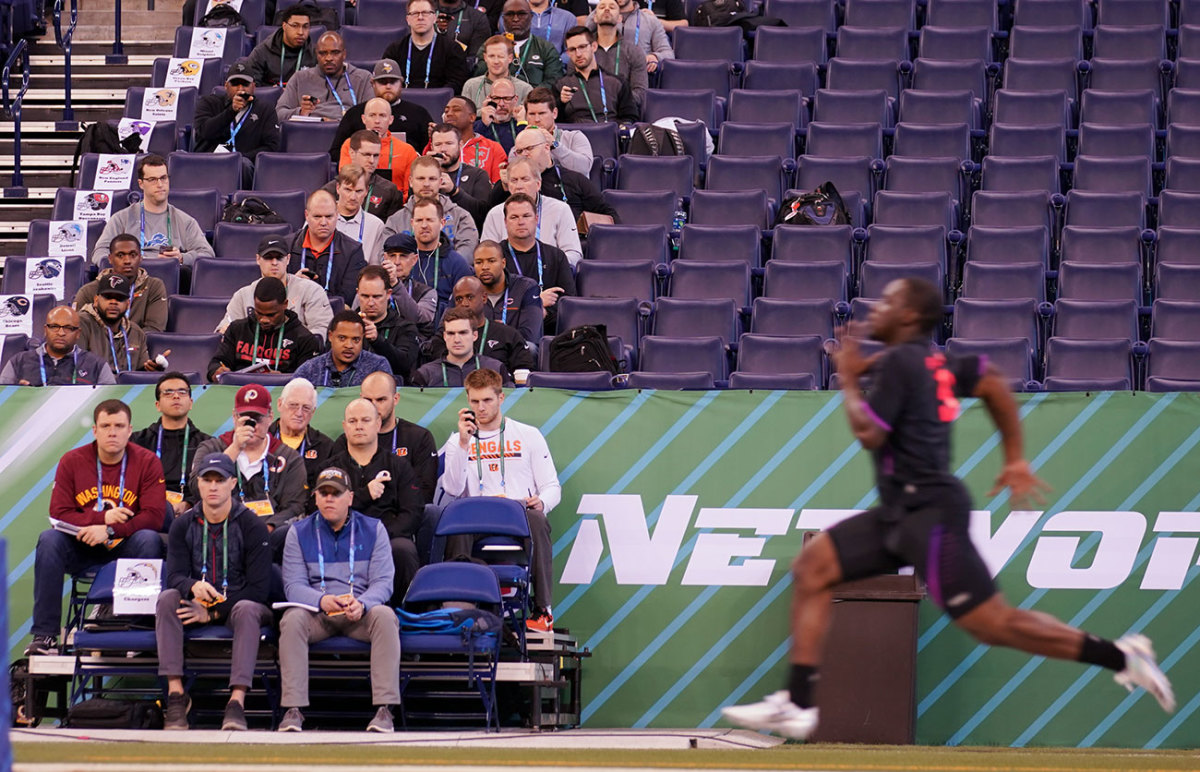
This is the combine in a nutshell: Every detail is carefully considered, right down to where people sit, on the off chance that it may matter in the slightest bit. The same is true for the on-field workouts, where team suites and positions at the finish line of the 40-yard dash are assigned via random drawing to ensure a level playing field, while many evaluators have specific seats around the stadium that they’ve claimed for years, determined by ritual as much as purpose.
“Habits,” said Giants GM Dave Gettleman, who has been attending the combine since 1986. “Just think about it this way: When I was teaching, kids would come in the first day, they’d sit in their spots, and I would never have to do a seating chart. They would be in the same seats every time. We are no different.”
Ask around the league, and there’s a method to the madness of who sits where and why. Here’s our scouting report on the rare part of the combine that you may not have heard much about—the seating chart.
The Team Suites
Three levels above the field, rectangular signs printed in the *NFL font* (you’d know the one we’re talking about) mark the suites that belong to each team for the four days of on-field workouts. The Colts, as the home team, always set up in the same suite, at midfield, next to the booth where NFL Network’s Rich Eisen and Mike Mayock broadcast the event. Everyone else gets entered into a random drawing, about a month before the combine, for the order in which they’ll select their suite location. Measures have been taken in the past to make sure teams know that the drawing is, indeed, random.
“The first couple years we did it, we kind of laughed because we thought well, [the teams] are going to think we played favorites, so we actually videoed the drawing in our office,” says Jeff Foster, president of National Football Scouting Inc., which organizes the combine each year. “More for fun, but sure enough, one of the teams was like, How did you guys do this? Are you sure that this was fair? Because of course they were at the tail end.”
This year, Pete Carroll, whose Seahawks got the 31st pick of suites, half-jokingly grumbled about their position. “So I think I’m sitting close to the JW Marriott,” Carroll said, referring to the downtown hotel that’s more than a half-mile away. The first three picks belonged to Denver, Kansas City and Washington, and each club chose spots along the path of the 40-yard dash, which is run along one sideline from the goal line to the 40-yard line. The Seahawks, picking last, ended up on the opposite sideline and on the opposite 20-yard line.
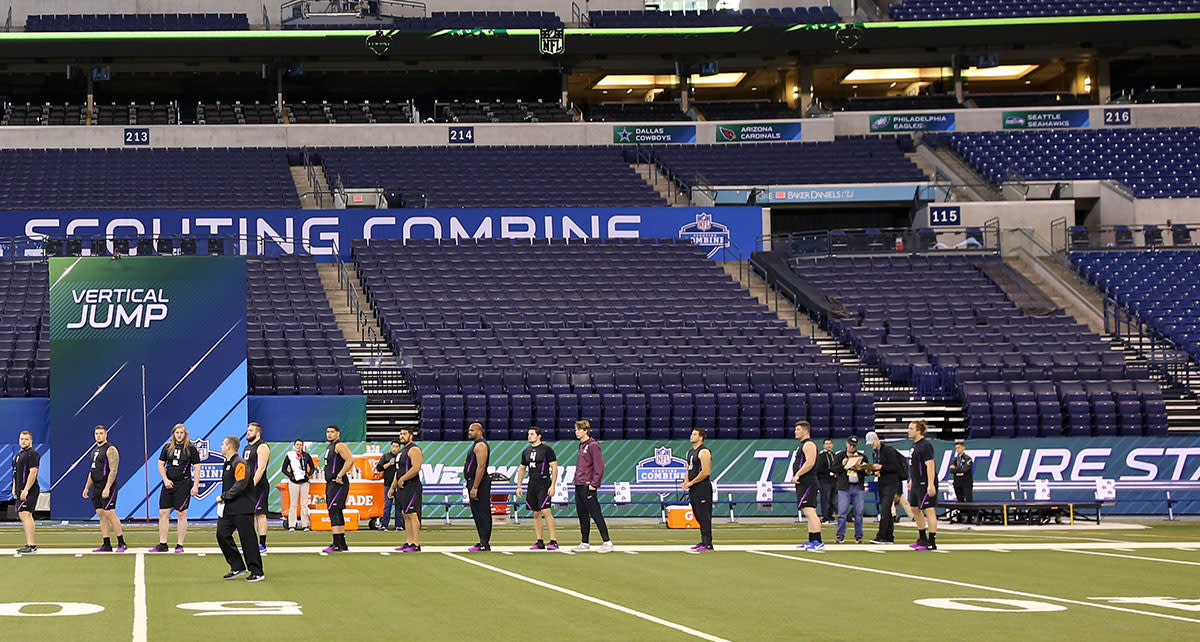
Once Foster and his staff do the drawing, they call each team in order and ask them to pick their suite from those remaining, like in the old days when you’d call the box office to buy tickets for a show. Teams ask a lot of questions—namely, who’ in the suites right next to the one they’re interested in. Usually, Foster says, it’s because they want to be close to a certain team, rather than not wanting to sit next to someone. But for what it’s worth, only two sets of divisional rivals were seated next door to each other this year (Broncos/Chiefs and Bills/Jets). On the other side of the Bills was Carolina, where Buffalo head coach Sean McDermott and GM Brandon Beane both previously worked.
Position doesn’t really matter, because team staffers can venture down wherever they want to go in the stands to get a better look. But many head coaches and GMs stay up in the box, where they can watch close-ups and replays on TV, tap notes on computers and communicate with their staff. “Last year I needed to be in the suite, because I was still getting to know everyone,” said Anthony Lynn, now in his second year as Chargers head coach. “This year, too, because I just haven’t been around the scouts enough. I want to get to know them and relate to them. But eventually I want to get down, just for position drills. I could care less about [being close for] the 40.” Lynn took a seat at the high-top counter in the suite, between GM Tom Telesco and college scouting coordinator Kevin Kelly.
“There used to be a time, before the suites were allocated, when I would go down to the eighth row and sit and watch the floor exercises there,” said Dorsey, who has the the No. 1 and No. 4 draft picks this year. “But I can sit in the suites and still effectively do my job. I’ve gotten lazy in my old age.” (He was clearly joking).
But the skyboxes aren’t just about the action on the field. It’s common, too, for business to be conducted at the suite level, where executives can easily visit with other teams away from the peering binocular lenses. In 2016, the Rams and Titans took advantage of being in adjacent suites as they negotiated a trade for the No. 1 pick of the draft. “You go to the bathroom sometimes, and you see two guys talking, and you think, ‘I wonder what the hell they’re up to,’ ” said Vikings GM Rick Spielman.
UCF LB Shaquem Griffin lit up the combine. Want to learn more? Check out Andy Staples’s profile of the inspirational UCF linebacker on SI TV.

Finish Line of the 40
When a player crosses the finish line of the 40-yard dash at the combine, hundreds of eyes inside the stadium—not to mention the viewers at home—are fixated on him. Concentrated at the finish line are rows of area scouts, stopwatch in hand, many with one eye squinted as if they’re looking through a telescope lens to focus clearly on an object. The finish is electronically timed, but each team collects its own hand times, too. The closer you are to the finish line, the conventional scouting wisdom goes, the more accurate the time. So, yes, seat assignments at the finish line are also randomly assigned.
When teams arrive in Indianapolis on the Tuesday of combine week, there’s a personnel directors’ meeting at the National Football Scouting office on S. Capitol Avenue. As the team reps walk in, each picks up a blank envelope with a number from 1 through 32 inside. That’s their row assignment.
Each row at the stadium is marked with a laminated placard printed with the team’s helmet logo and name. The first three rows—this year, the Chargers, Washington and Cincinnati—are positioned on risers on field level, with four folding chairs apiece in each row. From there the teams go back row by row in the stands, filling up Section 141. Oakland pulled No. 32 this year.
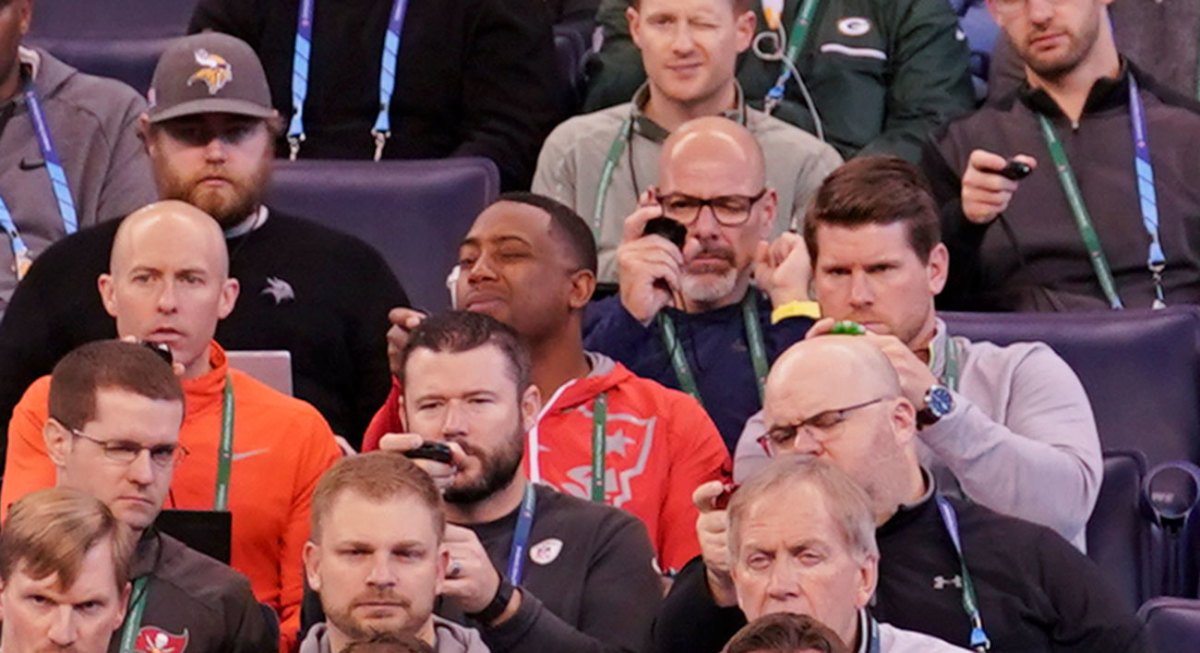
“We have had teams that will trade numbers, and they will actually trade back,” Foster said. “I have never asked them what, actually, they are trading. Maybe they are trading a drink at the bar later at night.” (No one we talked to copped to such an exchange).
Each team places its scouts—as few as two to as many as five scouts—at the finish line. But others prefer to watch the combine’s marquee event from a different vantage point. Gettleman sits at the starting line with a notebook and mechanical pencil. “I like to just watch [the players] get ready,” he said. “I like that vantage point.” Sometimes he’s joined by his scouts; on Sunday morning, the day the defensive linemen and linebackers worked out, Giants scout Chris Pettit sat one seat over holding a Starbucks coffee cup. “Anybody who wants to be around a fat old man,” Gettleman said.
The best-known combine perch in the NFL is that of Tom Coughlin, man of consistency, who annually claims his seat at the 10-yard line of the 40-yard dash, eight rows up from the field. Chris Driggers, the Jaguars’ director of pro personnel, who has been with the team since 1994, held that seat for Coughlin during his first stint in Jacksonville, then through Coughlin’s 12 seasons with the Giants, one year at the NFL office, and now with Coughlin back in Jacksonville as the executive vice president of football operations. During the defensive line sprints, Jags coach Doug Marrone joined Coughlin at his spot.
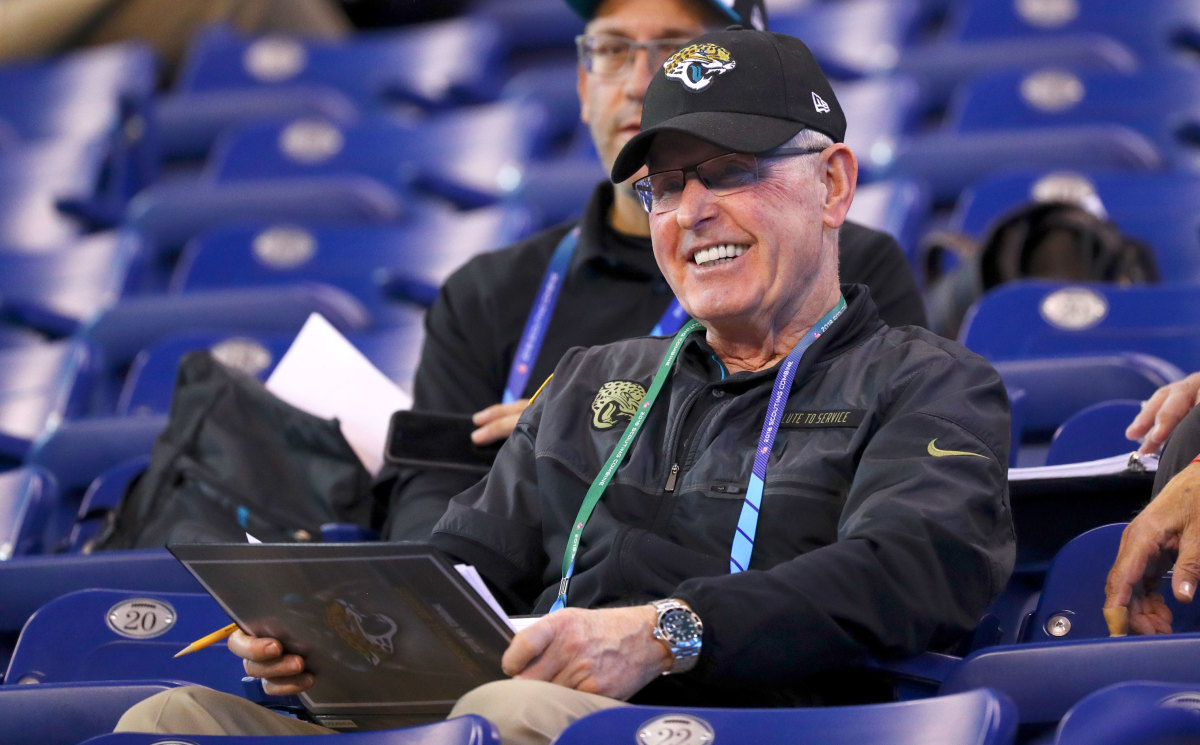
“I can see the players line up,” Coughlin said. “I know the tension that goes along with performing well in that, and it puts me real close to seeing the athlete. And the 10s [the first 10-yard splits] are important to me, too. For most positions—you take the bigger positions—the 10s are really what’s most important. Some of the guys that are there now, like Doug Marrone, they’re interested in the 10s as well.”
Around the Stadium
One GM said he likes to go to the end zone to watch the offensive line drills. Another team’s PR director said its GM, who was spotted near midfield in the stands, would prefer not to divulge the reason behind where he sits. It could give away a competitive advantage, he reasoned. (“Paranoia in the NFL for $1,000, Alex.”) Rams GM Les Snead stays in the suite for the 40-yard dash, then sometimes ventures down to Row 4 or 5 in the stands during position drills. There’s something to be gained, he says, from watching how players perform and react live, or even how they’re interacting with other players while waiting in line for the vertical jump (Ex: Oklahoma’s Baker Mayfield, by our own observation, stood with his arms crossed and mentally taking notes as the first group of quarterbacks completed their throwing drills).
“That way you get as close to guys as possible,” Snead said. “There’s a few guys starred that you really want to see. You are always gathering intel, data, to put in the file to help you make a decision. I don’t know how much that piece of data weighs, but you are always making notes about something, and sometimes it’s not about just how they look working out. If you’re watching receivers, it’s how athletically the receivers are getting in and out of breaks, how far are they behind in college, because they’ve still got development to do. But also, let’s say a receiver dropped the ball; you might see some kind of language, Uh oh, he hasn’t forgotten it yet. Everyone is going to drop a ball, so the key is, it can’t bother you for the next time. It’s little things like that.”
Ozzie Newsome, Ravens GM since 2002, has a routine all his own. His perch is at the top of the stadium, in the visitors’ coaching booth in the press box, with a crew he’s sat with for decades: assistant GM Eric DeCosta; Bengals coach Marvin Lewis; former NFL head coach Ray Rhodes, in past years; and, until this combine, Rick Smith, who took a leave of absence in January from his job as Texans GM.
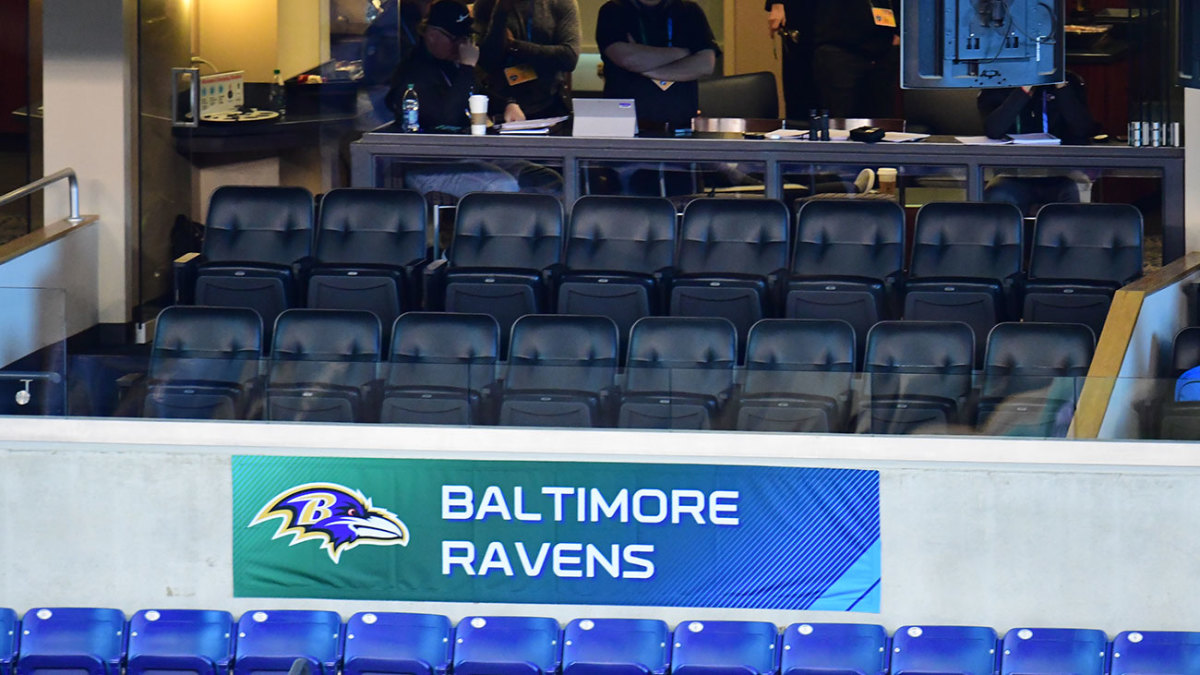
“I don’t want to give up our secret, but we have for years sat in the visitors’ press box, a group of about five or six, based on retirements and some guys getting fired or so forth,” Newsome said. “We’re down to just three right now. It’s right on the 40, and we get a bird’s eye view, and we also get the chance to have great conversations.”
John Lynch, second-year GM of the 49ers, is still honing his scouting routine. Last year’s suite placement was less than ideal, he recalled, but the 49ers got the eighth pick this year, and nabbed a spot right across from the finish of the 40-yard dash. “But I did find myself going, OK, Coughlin has been around a little while, and he sits there,” Lynch said. “I’m kind of a newbie here, so I was plotting.”
Most NFL evaluators likely didn’t put this much thought into a seating chart at their own weddings. But in the world of NFL scouting, every little detail is treated like it might make a difference—including where you sit.
Question or comment? Email us at talkback@themmqb.com.
